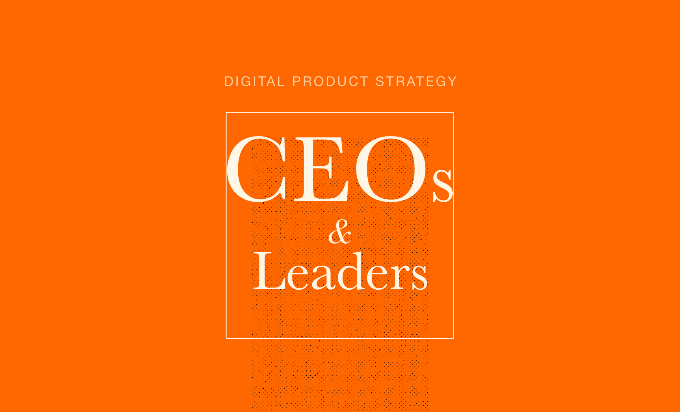Lead Your Organization to Make Exceptional Digital Products
9 min read
If you are like most CEOs or leaders responsible for web apps, mobile apps, or software, you probably sense your digital products are not as good as they should be.
Customers likely find your apps confusing, cluttered, and difficult to use.
Your call center and sales teams aren't exactly singing your praises either. New competing products look and feel more modern, behave more usefully, and change more rapidly. You have a nagging, persistent feeling you can do better.
Crunching the numbers reveals the truth. Dissatisfaction with your digital products is costing (or will soon cost) your company money and market share. This is the pain brought on by poor user experience (UX).
As a leader, you're uniquely positioned to address it.
First, a Word of Caution
You can't wave a magic wand and instantly make your apps or software less awful and more user friendly. If you want to provide truly exceptional digital products to the market, you must create an organization that can do it. That means fundamentally and actively building user experience principles and best practices into the soul of your company. If you're not ready to do that, stop reading. None of the advice below will work. Not one bit.
What You Can Do
Making better digital products entails pushing your organization to consider users differently and incorporating user-centered methods into the making process. In order to do this, you must first become familiar with this thing called "user experience."
Learn.
Leadership starts with knowledge. You need to get comfy-cozy with user experience, what it means, and what it can do for you. Ah, but it's hard to know where to start and the questions are, frankly, daunting. What does user-friendly mean? How do we change entrenched processes? Is our entire approach to customers and users correct? How should our team change? Isn't this all subjective? How do we measure success?
Don't let this complexity get in your way. You can make substantial headway quickly with a few simple steps.
1. Walk among your users.
Amelia Earhart, who knew a thing or two about herculean undertakings, famously said, "the most difficult thing is the decision to act, the rest is merely tenacity." You simply must decide to deeply understand your users. Radically get to know the real people using the products you make.
Talk to them. Observe them in their environment. Learn from them. Don't assume you know anything at all about their needs, wants, or behavior. Ask foundational questions. What do they do? Why? What gets in their way? Do everything you can to see the world from their perspective. Begin today. Be tenacious. Radically get to know the real people using the products you make.
Don't outsource or delegate this. You must be hands-on here. Once you've started spending time with users, you'll be ready to supercharge the learning process.
2. Read voraciously.
You don't need a dense list of esoteric user experience books. Start with the basics and read the disarmingly titled Don't Make Me Think by Steve Krug cover to cover. It's CEO-short and liberally peppered with engaging infographics and diagrams. I mean this in the very best way.
Once you've read this shockingly simple book, consider just a few more. We care so much about your limited time, we've created the World's Simplest UX Reading List. It features only four books (including Krug's).
These will start you far enough down the rabbit hole. From here, armed with your new knowledge and that go-to Google, you'll easily branch out to find your own reading material. Just never stop reading.
3. Attend a conference.
Conferences are a stellar way to jump start your knowledge base. Yes, I'm talking to you, the one who doesn't have time for this sort of thing. Don't all those business books on your shelf tell you to spend non-urgent time planning how your department, division, or company moves forward in the market? In a few days, a simple conference can change your entire perspective. Are you thinking budget is a problem? Please. Don't let a few hundred dollars separate you from the potential spark that changes your firm's trajectory. It's an easy decision.
You don't need to get into the weeds, you need high-level understanding. Try one of these excellent major UX conferences:
- An Event Apart These conferences feature renowned speakers and up-to-the-moment topics.
- NNgroup Long a standard setter for user experience and usability.
- UIE (Strategy Playbook) UIE is a major player in UX education.
Take key people with you but don't fully delegate participation. When you're building a personal knowledge base, you've got to be in the room.
4. Canvas your peers.
People just like you face similar problems. You undoubtedly have both industry and non-industry contacts who are trying to build solid digital products. Talk to them. Find out what they are doing. Find out what they've tried. Ask what they've spent. What has worked? What hasn't?
You'll be encouraged. You are not alone. The dialogue you establish will spark ideas that can lead to action. If nothing else, it's worth it in therapy value alone. Mediocre apps or software cost your company time and money.
Count the cost.
Mediocre apps or software cost your company time and money. Find out exactly how much. Perform an organization-wide digital product audit. First, identify the core, flagship products that mean the most to your business. Next, mine the products and their surrounding customer touchpoints for every relevant statistic you can find.
Establish metrics and measures.
You can start with this sample list:
Cost and Time
- Revenue
- Initial Development Cost
- Proposed Modernization Cost
- Product Maintenance and Upkeep
- Training Cost (internal and external)
- The Cost of Doing Nothing (a very real thing)
Mindshare and Engagement
- Market Share
- Total Customers/Users
- Adoption/Turnover
- Traffic and Specific Use (event tracking)
- Sign-Ups
- Leads Generated
UX/CX
- Call-Center: Average Call Time
- Call Center: Top Complaints
- User Satisfaction
- Usability (ability of users to accomplish key tasks)
Your criteria may be different. There are a number of ways to identify and track current product metrics. The important thing is to establish your baseline and, more importantly, put numbers to it. Get a spreadsheet junkie to distill it onto a (probably scary) spreadsheet. Measure every new step you take against this baseline.
Be prepared to invest.
It goes without saying that improving digital products will cost money, often lots of it. But staying put is not an option. You'll find that great user experience will almost certainly SAVE your organization money, even if you spend lots up front. That's a whole other topic. For now, measure relentlessly.
Build and cultivate an exceptional team.
Often, the most important thing we do as leaders is find the right people and put them in a position to succeed. This is tricky with UX, since the discipline is not broadly understood and still lacks universally recognized standards. Don't let that stop you.
Find and train internal talent.
Dollars to donuts, there are already people in your division or company who are deeply interested in making apps more relevant to users. Front line people may have tried to do user tests. They may constantly question current processes or methods. Find these people. Take them to lunch right away.
These people are the core of your new user experience practice. They may or may not be leadership material, but you can build around them. We could talk for a whole book about assembling a rock solid UX team. For now, encourage UX instincts among your current team. Share this post. Give them books. Send them to a conference or two. Discuss metrics with them.
Recruit new UX talent.
Moving forward with momentum means you'll almost certainly bring in new, established UX talent. Outside of major metropolitan areas, this can be disheartening. Most search firms struggle to understand UX roles and are at least a decade behind in UX practices. If you use a recruiting firm, quiz them mercilessly on what you've learned and read.
Hint: If your recruiter can't tell you what an information architect does or why a content strategist is important to stellar digital products, run away.
You will need at least one dedicated UX professional to lead a UX team. This person must have direct experience strategizing, defining, designing, and building digital products, preferably for a firm very much like yours. This will require time and attention. It's worth it. Google job descriptions for UX leads. You find many examples, and they will vary wildly. Just keep your description simple and build it based on your internal needs. Do not hire a UX team without giving them the ability to guide the creation of your digital products.
Give your staff responsibility.
Do not hire a UX lead or any other members of a UX team without giving them clear, institutional ability to guide the creation of your digital products. You are not hiring artists who make pre-defined screens "pretty." You are bringing in professionals to inform the making process from the beginning. If they are given no authority, your money will be wasted.
Think practice, not bodies.
As a leader, your vision and direction set the stage for building a UX culture in your organization. The UX team itself will be the instrument of that cultural change. Building it will take time. It's one thing to bring in unique skills to assist with individual projects. It is quite another to forge an internal, user-focused practice. This is a long-term play.
You cannot single-handedly fix every problem with your apps. Neither can a new UX team. But they can make steady progress. With or without external help, over time they will move the needle toward success on those metrics you identified.
Demand, demand, demand.
You can learn everything there is to know about UX, establish metrics that would make a Harvard MBA blanche, and build a truly empowered UX team. But if you want your organization to create strong digital products, you must vocally demand it, repeatedly and constantly.
This is no time for laissez faire management. Take every opportunity to remind everyone about the centrality of users. In every meeting, ask your key people how users have responded to prototypes. Ask about what users have taught them. Require your key people to push the boundaries of the metrics you've identified. Insist on world-class usability. It is the only way you'll achieve user experience improvement. I cannot possibly understate this.
Embrace your UX role.
As CEO, executive, or key leader, your job is to push your organization and shape it in ways that make it more attractive to the market. Building user-centered digital products with solid UX principles help do exactly that.
You don't write requirements, perform tests, move pixels, or author code. That's not your role. Bold vision, incisive leadership, and clear direction are your currency. Without these, no UX initiative will accomplish what you wish it would. There's no substitute for leaders who care deeply about the real-world use of digital products.
Put UX leadership in place.
There's no substitute for leaders who care deeply about the real-world use of digital products. Your organization probably has a head engineer. It probably has a CIO, and directors of business units. Likewise, someone must oversee user experience. You need a Chief Digital Product Officer.
At a high level, this can be the CEO, even if largely delegated. Otherwise you must help identify someone who can do it, appoint a person to fill this role, or become Chief Digital Product Officer yourself. This ensures user experience has clout in your company culture all the way up at the top, crucial to making UX part of how you operate every day.
Move Forward
I've used words like "relentless," "merciless," and "voracious." I've tossed in the occasional "repeatedly" and "constantly" for good measure. I want you to feel urgency, to exude determination. That's what it will take to revolutionize your digital products.
This is the new normal.
User experience is no longer a foreign concept in product and service strategy and design. It is no passing fad. Leaders must increasingly demand solid UX from their organizations and their digital products. This is simply the reality of screen-based products in the digital age. The world isn't getting less digital or less mobile. Users are not getting less demanding of apps or software. Leaders must respond.
Don't give up.
It's never easy to change the way a company attacks major challenges. Inevitably, the best counsel is patience. You will not transform your digital products in the course of a day, a quarter, or even a year.
Take heart (and a deep breath). You can do this. Then watch those metrics begin to soar.





